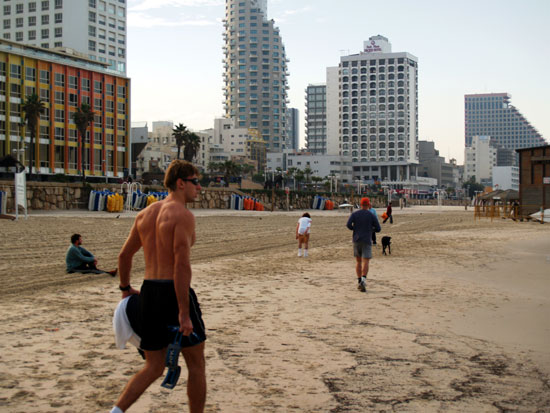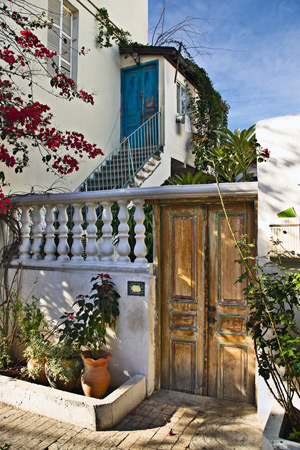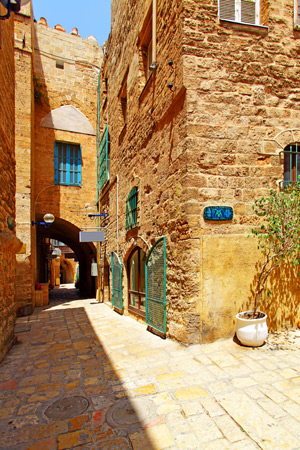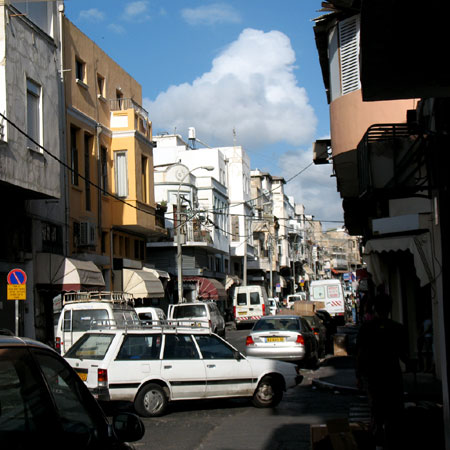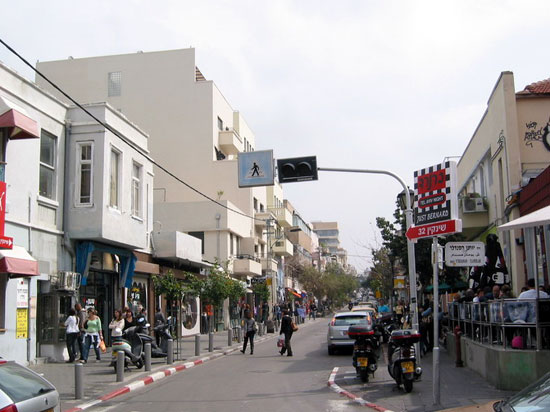The beachfront
Tel Aviv is often contrasted with its conservative sister, Jerusalem. Whereas religiously and politically tense Jerusalem is encompassed by a fortress of desert and hill, Tel Aviv sprawls next to the Mediterranean, giving the city a sense of freedom and reflecting Tel Avivan’s overwhelmingly liberal lifestyle. The city's nine miles of coastline ensure that relaxation is only a few steps away at all times.
The beachfront stretches from the southern suburb of Bat Yam to Nemal Tel Aviv (Tel Aviv Port) north of the city. Along the way, myriad bars, restaurants, and cafés crowd together, providing, if nothing else, a captivating people-watching scene. Like the beachgoer seeking a tan, Tel Aviv culture strips down and bares it all. Beaches are typically named after neighboring streets or hotels, and each stretch of sand projects its own personality beneath its seemingly uniform appearance. Hilton Beach has emerged as the gay-friendly beach, while Metzitzim Beach has a reputation for being a babe-magnet. By contrast, Nordau Beach hides behind a wall erected to protect the modesty of religious men and women who shun immodest dress in mixed company. Access to Nordau Beach alternates between the sexes daily, and is open to anyone who prefers a same-gender atmosphere. Volleyball players, fishermen, and wind surfers take up residual posts on the water, while on the beach, paddle ball is nearly a national competitive sport. A word of caution: when walking the beach, watch out for high-velocity balls that could leave an oblivious beachgoer with a concussion or an unsightly goose egg.
Neve Tzedek
In 1887, Neve Tzedek became the first Jewish settlement outside of Jaffa and hence the first neighborhood of modern-day Tel Aviv. When conditions became too claustrophobic and unsanitary in Jaffa, the Jewish immigrants ventured out and began building what would eventually become one of the world’s most important cities.
Neve Tzedek is at once a testimony to Tel Aviv’s past and a vibrant modern center popular with young Israelis and artists. Nicknamed "little Paris," this charming neighborhood, with its squat houses with red-tiled roofs, gives off a distinctly European flavor. Although the quiet, narrow streets are more reminiscent of a small French village than sophisticated, bustling Paris, Neve Tzedek is just about as Euro-chic as Tel Aviv gets. Israelis and tourists alike eat it up. Cafés, fashionable restaurants, boutiques, art galleries, a prestigious performing-arts center, and historical houses-cum-museums provide a calm and sophisticated contrast to the frenetic current buzzing throughout the rest of the city.
Israeli artists have had a presence in Neve Tzedek throughout its history. In the early 1900s, Nobel Prize-winning author S.Y. Agnon and artist Nachum Gutman created their masterpieces here. The arts tradition continues today in this upscale artist enclave. Perhaps the most beloved establishment here is the Susan Dellal Center for Dance and Theatre, which typically hosts performances that explore the Israeli identity.
As Tel Aviv grew far beyond Neve Tzedek, the neighborhood fell into disrepair and faced destruction. Fortunately, in the 1980s a move was made to preserve the vicinity's historical houses, and over time the area experienced a metamorphosis from a slum into an prosperous neighborhood featuring luxury residences and some of the highest home prices in all of Tel Aviv. Many of the houses owned by the founders of the community have been converted into museums, such as the Rokach House . Just wandering the streets of Neve Tzedek, one will encounter plaques and historical sites that pay tribute to the early days of Tel Aviv.
Jaffa (Yafo)
Jaffa juts out into the Mediterranean at the southern end of Tel Aviv like a monument to the past. Jaffa (also known as Yafo) dates back to the Bronze Age and has been conquered, leveled, and ruled by about as many civilizations as Jerusalem has. It also claims several mentions in the Bible, which uses the latinized name variation, Joppa. This small city was a hub of Arab life from the 16th century, when the Ottomans took it over, to the early-mid 20th century, when tens of thousands of Arabs fled conflicts with British and the growing Jewish population. After the creation of Israel, Jaffa was incorporated into Tel Aviv. Currently Jews, Christians, and Muslims live relatively quietly together in Jaffa, but Jews make up the vast majority of the population.
The summit of Old Jaffa is dominated by pedestrian paths that wind past art galleries tucked into stone alleys, gardens, and lookouts over the sea. Other attractions include the 19th-century Franciscan church, St. Peter’s, built on the alleged site of Peter’s resurrection of Tabitha (Acts 9:36), and an 18th-century synagogue once the domain of Libyan Jews, which is now a museum. This scenic hill attracts numerous brides and grooms seeking out the most photogenic backgrounds the city has to offer. Heading away from charming Old Jaffa, one encounters a more raw, earthy atmosphere. The Shuk HaPishpeshim, Jaffa’s famous sprawling flea market, takes over the streets, which are dotted with hummus joints and fish restaurants. Here you'll find some of Tel Aviv's most authentic dining, so if you’re only around for a short time, plan your meals around this visit. The clock tower is Jaffa’s focal point and a good meeting place, especially for tourists prone to getting lost.
Florentin
Neighboring Jaffa in south Tel Aviv, Florentin (pronounced Florenteen) is a diverse neighborhood with a bohemian flavor. Given its attraction to young, edgy artists, it seems reasonable to expect Florentin to eventually become another Neve Tzedek. But like the Neve Tzedek of yesteryear, Florentin is precariously close to falling apart.
This low-rent neighborhood enjoyed a slight reputation makeover when an Israeli television show was set here. Florentin residents, especially the young Israeli ones, take pride in the area’s urban edge the way other young artists take pride in the rough-and-tumble neighborhoods they inhabit before the area gives way to revitalization and gentrification. The particular charm of Florentin lies in its old-fashioned industries. Workshops and stores specializing in fabric, upholstery, carpentry, lighting and the like line the streets, with each industry occupying a different street. Several of Tel Aviv’s most popular restaurants among the young crowd are in Florentin. While it doesn't offer much in the way of sightseeing, Florentin is an eccentric stroll toward Jaffa or the beach. Stop in for an espresso and a sense of Tel Aviv’s young and diverse future.
City Center
The city center is the one part of Tel Aviv (aside from the beach) that is impossible to miss. It is the area's—if not the country's—destination for shopping, culture, food, and fashion. The difference in the human climate from other cities and towns around Israel is palpable: Tel Avivans shop and idle away the day at stores and cafés on Sheinkin Street; they read on benches on Rothschild Boulevard; they stop for ice cream or fruit juice on Ben Yehuda Street on the way home from the beach. Tel Aviv has always been known for its café culture, and the best way to get to know the city is to sit in an outdoor café alongside gruff old men drinking cappuccinos and reading the newspaper. Unless they’re doing business in the Azrieli Towers, it is hard to believe that anyone works at all in Tel Aviv.
For the purposes of the tourist, the city center consists essentially of Allenby, Rothschild, Sheinkin, King George, and Dizengoff Streets. Slightly outside these artificial lines is Ben Yehuda Street, which runs alongside the beach and the Azrieli towers. King George sports a market and several shops specializing in discount clothing, while nearby Sheinkin Street shimmers with hip cafés and designer stores. Dizengoff Center sports a large mall with an indoor movie theater and a store that makes custom T-shirts with classic Israeli ads. To understand the full impact of central Tel Aviv, it may help to know that the experience of walking down Dizengoff Street has been crystallized into a new Hebrew verb used to describe going out on the town: lehizdangef.
Article written for World Trade Press by Emily Keeler Alhadeff.
Copyright © 1993-2026 World Trade Press. All rights reserved.



